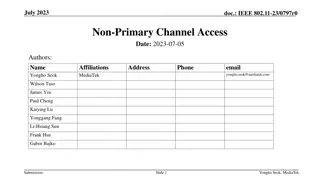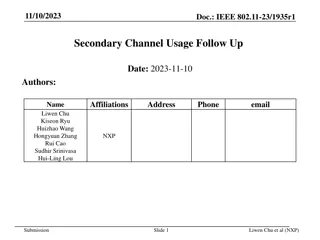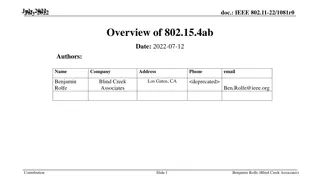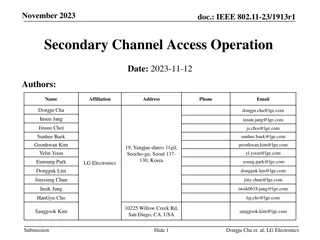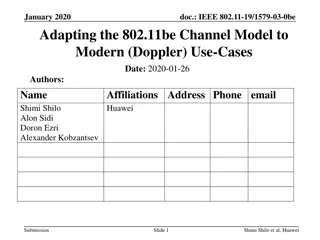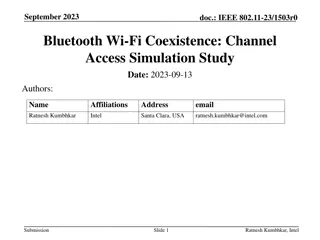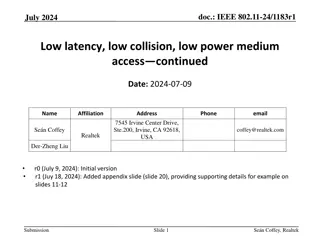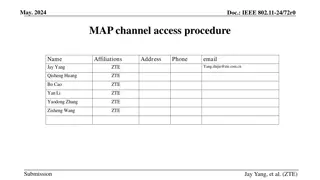
Efficient Scheduled Channel Access in Next-Generation IEEE 802.11
Explore the advancements in medium-efficient scheduled channel access for the next generation of IEEE 802.11 networks, emphasizing the optimization of OTA signaling overhead to enhance latency, throughput, and reliability in various scenarios across different environments and applications.
Download Presentation

Please find below an Image/Link to download the presentation.
The content on the website is provided AS IS for your information and personal use only. It may not be sold, licensed, or shared on other websites without obtaining consent from the author. If you encounter any issues during the download, it is possible that the publisher has removed the file from their server.
You are allowed to download the files provided on this website for personal or commercial use, subject to the condition that they are used lawfully. All files are the property of their respective owners.
The content on the website is provided AS IS for your information and personal use only. It may not be sold, licensed, or shared on other websites without obtaining consent from the author.
E N D
Presentation Transcript
July 2023 doc.: IEEE 802.11-23/0936r0 Medium efficient scheduled channel access in next generation 802.11 Date: 2023-07-07 Authors: Name Dibakar Das Affiliations Intel Corporation Address Phone email Dave Cavalcanti Dmitry Akhmetov Laurent Cariou Javier Ramirez-perez Submission Slide 1 Dmitry Akhmetov et al. , Intel Corporation
July 2023 doc.: IEEE 802.11-23/0936r0 Introduction In 1926r0 we show the need for optimization of OTA signaling overhead to improve latency, throughput and reliability KPIs in various scenarios Existing tools (SP allocations/SCS/QoS/Trigger Frame) enable better control of channel access but do NOT take full advantage of known scheduling requirements The OTA overhead result in efficiency/capacity loss for the overall network The range of scenarios where such improvements needed is broad: Any environment (home, enterprise, industrial) where triggered and scheduled access is involved Large number of application have predictable frame arrival pattern Any real-time video- or audio- based application operates on predictable frame arrival (i.e., data burst every X ms where X is a function of FPS value/codec properties) XR and Gaming applications follow predictable frame arrival patterns as well Even some local TCP-based flows (some XR flows may use TCP for data delivery; local file transfer) A BSS with a mix of periodic and bursty applications benefit from optimized signaling, regardless of operation environment Submission Slide 2 Dmitry Akhmetov et al. , Intel Corporation
July 2023 doc.: IEEE 802.11-23/0936r0 State of the Art: Scheduling with 802.11ax/be Scheduled operations (r)TWT SP reservation/negotiation Triggered access. MU and SU P2P operations QoS Signaling SCS/QoS Characteristics Gaps: Efficient and granular medium opportunities within allocated/negotiated SP or regular TXOPs Large OTA signaling overhead No support for repeating operations or semi-static operations that leverage QoS signaling Submission Slide 3 Dmitry Akhmetov et al. , Intel Corporation
July 2023 doc.: IEEE 802.11-23/0936r0 State of the Art: (r)TWT rTWT provides protection and increase the chance for to AP get access to the channel EDCA TXOP rTWT SP QoS Setup/Negotiation (SCS/TSPEC/rTWT setup) TF + UL DATA1 + BA (STA1-STA4) TF + UL DATAx + BA (STA9-STA10) TF + UL DATA3 + BA (STA7-STA8) DL DATA2 + BA (STA5-STA6) Depending on SP configuration (i.e. # of subscribed STAs, traffic periodicity, interarrival time, priority, burstiness) there is a trade off between power save and latency and medium efficiency: Shorter SP with smaller number of devices which may lead to resource underallocation, especially with high OTA signaling overhead Longer SP with bigger number of devices which need to be present for longer time for service Every triggered operation require a separate indication Submission Slide 4 Dmitry Akhmetov et al. , Intel Corporation
July 2023 doc.: IEEE 802.11-23/0936r0 Proposal 1: The need for announcement A WiFi system would benefit from an upfront indication of a planned activity The Announcement Frame can indicate TX/RX parameters upfront and describe SP/TXOP structure for better medium and power efficiency Submission Slide 5 Dmitry Akhmetov et al. , Intel Corporation
July 2023 doc.: IEEE 802.11-23/0936r0 Efficient scheduling operations for WiFi 8 EDCA TXOP rTWT SP TF + UL DATAx + BA (STA9-STA10) DL DATA3 + BA (STA7-STA8) TF + UL DATA1 + BA (STA1-STA4) DL DATA2 + BA (STA5-STA6) Resource Allocation / Announcement / Signaling QoS Setup/Negotiation (SCS/TSPEC/rTWT setup) STA 9 & 10 wake up here STA 7 & 8 wake up here I have nothing to TX to you and you have noting to send to me STA 5 and 6 can go to sleep Can be a phase or just a one-frame announcement I plan to serve you in a second sequence be present in 3 ms I plan to serve you in 3rd sequence be present in 4 ms From polling I know that you have X data to TX Announcement / resource allocation based on polling or QoS setup Optional polling for presence \ resource requests Resource allocation/Announcement signaling based on polling or QoS setup A single frame (or a phase) at the start of TXOP or SP may explicitly announce structure of ongoing operations May include: list of participating STAs based on optional pre-polling or prior QoS negotiation/TWT setup/Traffic analysis Duration of planned frame exchanges for more efficient power saving at STAs side Optionally announce TX/RX configuration for planned operations to reduce OTA overhead from individual TF/Sig-B/U-SIG Note: this can be used for both scheduled and unscheduled operations, i.e. EDCA TXOP and TWT SP optional polling can be done using existing NFRP or BRS frame exchanges Submission Slide 6 Dmitry Akhmetov et al. , Intel Corporation
July 2023 doc.: IEEE 802.11-23/0936r0 State of the Art: Triggered access with 802.11ax/be An AP provide full TX/RX config for STAs participating in any Triggered sequence, whether it is DL or UL Basic TF size: 20 (HDR) + 8 (C. Info) + X*(5+1) (U. Info) 4 users: 28+24=52 bytes 8 users: 28+48=72 bytes 16 users: 28+96=124 bytes Triggered TXOP/ TWT SP @ MCS 0 Periodic Data 2ms UL MU PPDU For predictable data flows it is reasonable to expect: TF BA The use of SCS\TSPEC to provide service/flow requirements to an AP SIFS SIFS The use of TWT/rTWT for service static or semi-static pattern 16 s 16 s 128 s 200 s 298 s* (53 s PHY preamble) Repeat from TXOP to TXOP or from SP to SP 658 s AP may group STAs with similar traffic requirements/TX requirements Overhead =??? ????? =413 658= 0.62 ??? And yet AP include all information for every triggered frame exchange even if this information is the same OTA overhead is of the same order as data TX time, e.g. ~60%, 256B and 20Mhz @MCS8 The OTA overhead per transmission sequence leads to inefficient medium use especially when available airtime is limited Negotiated SP is relatively short, or medium is fragmented by an SP reservation pattern ~80%, 256B and 80Mhz @MCS8 ~40%, 10Kb and 80Mhz @MCS8 Submission Slide 7 Dmitry Akhmetov et al. , Intel Corporation
July 2023 doc.: IEEE 802.11-23/0936r0 Proposal 2: The need for OTA optimization Something that is not changing should not be repeated Assign resources\parameters prior to actual frame exchange Use compressed indication to reference the assigned parameters Reuse assigned resources/parameters when needed Submission Slide 8 Dmitry Akhmetov et al. , Intel Corporation
July 2023 doc.: IEEE 802.11-23/0936r0 Efficient triggering operations for WiFi8 ... ... rTWT SP1 rTWT SPx EDCA TXOP1 Resource allocation/negotiation In frame exchange(s) prior to SP/TXOP start E.g. : An AP can use regular TF/Sig to address groups of station with TBD signaling to indicate whether the group/configuration is persistent or not and assign a unique ID to that group/configuration TXOP or TWT Service Period Resource Allocation UL/DL frame exchange UL Frame exchange DL Frame exchange Announced at a start of TXOP/SP standalone or as a part of a learning phase before TXOP/SP Efficient Resource signaling E.g. : An AP can provide information upfront in an announcement frame at a start of TXOP/SP for each group/configuration with unique ID to address it Efficient/reg. DL Efficient/regl TF in short(er) frames/fields using unique ID to address pre-allocated configuration(s)/STA groups Ack Ack If necessary, an AP may renew/replace old configuration using same mechanisms (as above) or perform partial update using TBD frame exchange/signaling Submission Slide 9 Dmitry Akhmetov et al. , Intel Corporation
July 2023 doc.: IEEE 802.11-23/0936r0 Enhancing existing WiFi 7 triggering features into WiFi8 Today the SIG-B/U-SIG field and corresponding TF fields carry complete description for operation in DL and UL direction for all participating devices. This is required for every exchange even if parameters are the same from TXOP to TXOP or from SP to SP Configurations/Parameters allocation/negotiation An AP may distribute TX and RX parameters for groups of stations prior to actual data sequence extend legacy exchange with additional TBD signaling whether the allocation is persistent or not in a separate new resource announcement-like frame which may carry SP/TXOP structure description as well as a part of a new management frame exchange (e.g. part of SCS/TWT setup) AP may maintain multiple parameter sets for multiple STA groups Configurations/Parameters indication At a start of DL (in SIG-B/U-SIG equivalent a.k.a. Efficient Sig-B or in Lite Sig-B ) or UL (in TF equivalent a.k.a. Efficient TF or Lite TF ) an AP indicate parameter set index to use during scheduled frame exchange Configurations/Parameters update AP may update/replace entire configuration by sending new one AP may distribute new one with the new ID AP may perform partial update using TBD frame exchange/signaling The use of legacy signaling is not prevented Submission Slide 10 Dmitry Akhmetov et al. , Intel Corporation
July 2023 Example of efficient scheduling and triggering for WiFi 8 Generic TXOP (EDCA or TWT SP) doc.: IEEE 802.11-23/0936r0 The structure allow Indicate TXOP/SP structure beforehand for participating STAs to optimize power Reduce OTA overhead by compressing it in one unified frame at a start of TXOP/SP Efficiently indicate TX/RX information for each individual frame exchange AP Negotiation/A Sequence1: UL STA1-STA4 Config1 Sequence 2 UL STA2-STA8 config 2 Sequence X DL STA1-STA4 Config 7 Announcem (optional) (optional) Resource Resource llocation controlled EDCA access ent P2P Lite-Trigger TXOP-level Announcement List frame exchanges with projected durations Lists STAs per sequence Corresponding configuration IDs or Optionally Full TX/RX config for each or for some sequence(s) Partial TX/RX config if update needed Lite ACK Lite ACK Lite-DL Resource negotiation Can be done as a part of independent management frame exchange Can be propagated using regular Trigger Frame with additional indication to reuse it for future Can be announced at a start of SP/TXOP in a new TXOP-level announcement frame Lite-Trigger Sequence ID Configuration ID Lite SIG-B\U-SIG Sequence ID Configuration ID Low Overhead exchanges using pre-allocated TX/RX configuration Further optimization is possible for better efficiency such as preamble optimization (no legacy?), ack optimization, etc. Other thoughts The TXOP-level announcement and efficient (compressed) OTA signaling are independent. One can function without the other one Recovery mechanism is in hands of an AP as AP is THE TXOP OWNER. In case of a failure an AP decide to retransmit/solicit frames as a part of the same sequence or later the same TXOP or in the next one. The announced projected duration for each sequence is not limiting Further optimization for rigid TXOP structure is possible to achieve lower latencies Submission Slide 11 Dmitry Akhmetov et al. , Intel Corporation
July 2023 doc.: IEEE 802.11-23/0936r0 Conclusion We presented some ideas to improve triggered and scheduled channel access for better medium utilization with Structuring of a TXOP/SP to efficiently schedule bursty traffic together with others. Upfront resource allocation/assignment Reduction of OTA signaling overhead by reusing repeating information to take advantage of known traffic patterns, whenever applicable. Submission Slide 12 Dmitry Akhmetov et al. , Intel Corporation
July 2023 doc.: IEEE 802.11-23/0936r0 SP SP1: Do you support the idea of optimizing scheduled channel access by accounting for both predictable and bursty traffic (e.g. by reducing OTA overhead/signaling)? SP2: Do you support the idea of structured TXOP/SP with multiple DL and UL exchanges (by using an TXOP announcement frame) ? SP3: Do you support the idea of upfront TX/RX parameters/resources allocation with an indication using optimized signaling during frame exchange? SP4: Do you support the idea of upfront TX/RX parameters/resources allocation and TX/RX parameters reuse in an SP/TXOP? Submission Slide 13 Dmitry Akhmetov et al. , Intel Corporation
July 2023 doc.: IEEE 802.11-23/0936r0 Back up Submission Slide 14 Dmitry Akhmetov et al. , Intel Corporation



